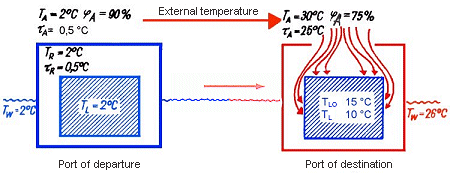 |
|
TA - temperature, external TW - water temperature TL - cargo temperature φA - rel. humidity, external |
TR - hold temperature TLO - cargo surface temperature |
| Figure 29: Formation of cargo sweat in the event of a rise in air temperature due to sea route: voyage into the tropics; U. Scharnow [46] |
However, in this case it is important not to underestimate the level of air exchange through the small ventilation openings and leaks at the doors which arise in strong winds. This air exchange is sufficient to initiate corrosion processes and other physical, chemical or biotic processes in goods, such as granulated sugar in bags, cement, chemicals etc., which have already been detrimentally affected by slight moisture deposits. In such cases, these openings should be closed (use of sealants) and care should be taken to seal the doors well, as many of these goods create their own cryptoclimate which is perfectly suited to storage.
The possibility of stopping air exchange also creates the conditions for new transport operations which would not hitherto have been contemplated or were associated with considerable risk, e.g. transport of white sugar from Europe to the tropics in the winter. On unpacking, it was found that the sugar had released moisture from the inside outwards onto the bags (jute bags) in which it was wrapped and the surface had caked, i.e. become hard. This pattern of damage may be explained as follows.
On relatively long voyages, the inner bags of the stack remain cold for longer; due to the different sorption behavior, water vapor is conveyed from the warmer outer sugar to the colder sugar inside the stack. This resulted in water stains on the sugar bags of the cold cargo core, while the outer bags became caked.
Goods which are stowed in the container as a large block cannot warm up over the course of a voyage of just a few days. Ventilation conditions are not provided. On unpacking, the bags become wet due to condensation of the warm, moist tropical air on the still cold bags, before they can be handed over to the receiver.
The container should not be opened immediately at the port of destination. The cargo, which is sealed off from the external air virtually hermetically, then has time to adjust to the temperature level of the port of destination.